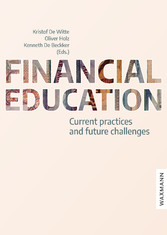Suchen und Finden
Service
Cover
1
Imprint
4
Contents
5
Preface
7
References
9
Chapter 1: Financial literacy. Uncovering avenues for future research (Kenneth De Beckker)
11
1.1 Introduction
11
1.2 Defining and measuring financial literacy
12
1.2.1 Test-based measures
14
1.2.2 Self-assessment measures
15
1.2.3 Outcome-based measures
15
1.3 The level of financial literacy around the world
15
1.4 Determinants of financial literacy
17
1.4.1 Socio-economic determinants
17
1.4.2 Financial socialization
19
1.4.3 Culture
20
1.5 Financial literacy and its consequences
24
1.5.1 Household financial decisions
24
1.5.2 Retirement planning
25
1.5.3 Investment decisions
25
1.5.4 Wealth
27
1.5.5 Other
27
1.6 Improving financial literacy
32
1.6.1 Financial education
32
1.6.2 Financial advice
34
1.7 Conclusion
34
References
35
Chapter 2: A comparative analysis of pupils’ and teachers’ financial competencies in five European countries (Kenneth De Beckker, Kristof De Witte and Oliver Holz)
41
2.1 Introduction
41
2.2 Data collection and methodology
42
2.3 Descriptive statistics
42
2.3.1 Pupils’ survey
42
2.3.2 Teachers’ survey
45
2.4 Descriptive results
45
2.4.1 Pupils
45
2.4.2 Teachers
47
2.5 Regression results
49
2.5.1 Pupils
49
2.5.2 Teachers
54
2.6 Conclusion
57
References
57
Appendix A: Pupils’ survey
59
Appendix B: Teachers’ survey
64
Appendix C: Locus of control items
66
Chapter 3: Financial education in Flanders (Belgium) (Kristof De Witte, Kenneth De Beckker and Oliver Holz)
67
3.1 Financial education in 2019 in Flanders (Belgium)
67
3.1.1 Financial literacy levels
67
3.1.2 The route to financial literacy in Flanders
71
3.1.3 Example initiatives
72
3.1.4 Challenges ahead
73
3.2 Curricula and teaching materials of secondary education
77
3.2.1 Flemish secondary education system
77
3.2.2 History of financial literacy in secondary education
78
3.2.3 The curriculum in the first cycle of secondary education
79
3.3 Extra-curricular initiatives by Wikifin.be
82
3.3.1 Wikifin lab
82
3.3.2 Wikifin research chair
82
3.4 Trends
83
References
83
Chapter 4: Financial education in Estonia (Kaire Põder, Leonore Riitsalu and Karmo Kroos)
87
4.1 The past situation in Estonia with respect to financial literacy
87
4.1.1 Evolution in the levels of financial literacy
87
4.1.2 Discussions on the levels and necessity of improving financial literacy
93
4.1.3 Overview of past policy attention
93
4.2 Provision of financial education: schools, universities and the financial sector
96
4.2.1 Implementation in the education curriculum?
96
4.2.2 Is there attention to financial literacy in teacher training?
98
4.2.3 How do various initiatives reach students and the general population?
100
4.2.4 Is there a lot of attention from the government?
104
4.2.5 Overview of evidence on tools that exist to promote financial literacy
105
4.3 The future of financial literacy in Estonia
106
4.3.1 Remaining difficulties and issues
106
4.3.2 Necessary steps to be taken
106
References
108
Chapter 5: Financial education in Italy (Tommaso Agasisti and Marta Cannistrà)
111
5.1 Financial literacy: Italian situation
111
5.1.1 How does the Italian population rank relative to other countries?
111
5.1.2 Main differences among Italian population
114
5.1.3 Performance of Italian 15-year-olds
120
5.2 Financial literacy at institutional level
123
5.2.1 Past policy attention
123
5.2.2 Financial education at school in Italy: the curriculum
125
5.2.3 Financial education at school in Italy: teacher training
126
5.3 Financial education: current situation in Italy
126
5.3.1 Initiatives
127
5.3.2 Institutions and actors involved
134
5.3.3 Focus: Economia@Scuola – FEDUF
135
5.3.4 Focus: CONSOB initiatives
137
5.3.5 Focus: The Bank of Italy – I quaderni didattici (the Didactical booklets)
138
5.4 Conclusions and future perspective
139
References
141
Chapter 6: Financial education in the Netherlands (Aisa Amagir)
143
6.1 Introduction
143
6.2 Literacy, financial literacy and financial education: definitions
145
6.2.1 Financial literacy and financial education
146
6.2.2 Financial literacy levels
147
6.2.3 Financial literacy levels among Dutch students
147
6.3 Financial education: current situation
150
6.4 Educational system
151
6.4.1 Primary education
151
6.4.2 Secondary education
152
6.4.3 Vocational education and higher education
154
6.5 Extra-curricular initiatives
154
6.6 Conclusion
155
Acknowledgments
155
References
156
Appendix 1
159
Appendix 2
162
Appendix 3
164
Appendix 4
166
Chapter 7: Financial education in the Slovak Republic (Jana Klieštiková, Mária Kovácova and Pavol Durana)
171
7.1 Financial literacy to date
171
7.1.1 Evolution in the levels of financial literacy and overview of past policy attention
171
7.1.2 Discussions on the levels and necessity of improving financial literacy
178
7.2 Current state of education in financial literacy in the Slovak Republic
178
7.2.1 Financial literacy according to the Ministry of Education, Science, Research and Sports of the Slovak Republic (implementation in the education curriculum and level of attention of the government)
179
7.2.2 Financial literacy according to the teaching materials and other institutions providing education in the given area (attention in teacher training, initiatives for students and general population and evidence on tools to promote financial literacy)
183
7.3 The future of financial literacy in the Slovak Republic
187
References
189
About the authors
191
Alle Preise verstehen sich inklusive der gesetzlichen MwSt.









